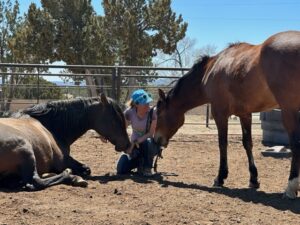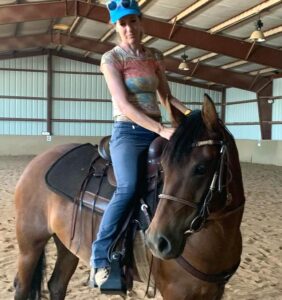Editor’s Note: Best Horse Practices Summit presenter Katrin Silva grew up riding dressage in Germany before moving to the United States at age 19 to learn to ride Western. She’s been riding both disciplines for the last 20 years and is a regular guest columnist for Cayuse Communications. The author of Dressage for All of Us: How to Help Any Horse Become a Happier, More Responsive Riding Partner and the forthcoming Ride with Feel: A Guide for the Rest of Us lives in New Mexico where she works with dressage and Western clients.
 Katrin Silva writes:
Katrin Silva writes:
When does a training session start? When I swing my leg over the horse’s back? When I pick up the reins? When I ask for the first step of trot after the warmup walk?
No. My time with a horse begins before I ever put a foot in the stirrup, before I even touch him. My work begins as soon as I approach a horse. As soon as he is aware of me, he lets me know how he feels. As soon as I’m with him, I get feedback about how he relates to me and about what he is thinking. There are times when that feedback is positive. A horse who is dozing in the turnout, stays lying down as I walk in, and allows me to sit quietly with him for a few minutes shows me that he trusts me. When that happens, especially with a horse who is just learning to trust me, I feel so touched and honored that I usually decide to let him finish his nap and work with another horse instead.
Many other times, the feedback is not so positive, ranging from the equivalent of a giant eye roll (“You again!”) to a clear thumbs down (“I hate what we’re doing!”). Horses never lie, but I can’t take what they tell me personally. I can, however, turn negative feedback into learning opportunities:
When I walk up to him, does he come toward me or turn away from me? If he turns away, I know it’s not about me. Many horses have good reasons to feel unenthusiastic about a human with a halter – or they may just want to hang out with their friends instead of with me right now. Rather than feel annoyed, I use the time as an opportunity to create trust and connection.
Does the horse brace his neck and raise his head away from the halter?
 If so, I don’t think “He’s being a jackass who is making my job harder.” I know he’s doing it out of habit, or because he is anticipating discomfort. Rather than wrestle the halter over his nose and ears, I get him to lower his head and relax until I can slip the halter on slowly and smoothly. I use the extra time to establish a sense of calm relaxation.
If so, I don’t think “He’s being a jackass who is making my job harder.” I know he’s doing it out of habit, or because he is anticipating discomfort. Rather than wrestle the halter over his nose and ears, I get him to lower his head and relax until I can slip the halter on slowly and smoothly. I use the extra time to establish a sense of calm relaxation.
Does the horse lead like a willing, respectful partner, or does he have other ideas, like lagging behind me or charging ahead? Is he with me, or is he focused on something else? Is he aware of my personal space?
Leading is an opportunity to establish boundaries, focus, and confidence.
Does the horse seem to enjoy getting ready to work?
I try to keep or deepen a calm, focused mood while grooming and saddling. A horse who flinches or pins his ears as soon as he feels the curry comb or the girth may have ulcers or need a chiropractic adjustment. More commonly, I think he is expecting an abrupt, unpleasant sensation. Again, this is useful feedback for me. I slow things down and experiment with different kinds of touch and grooming tools to see how we can make things better.
Does the horse stand quietly at the mounting block or does he fidget?
 If he is anxious or impatient, I may just place my foot in the stirrup and take it back out, then walk the horse around the mounting block and repeat. I may get on and off a couple of times. I may get on, work for a while, and then get on and off a few more times. The mounting bock is an excellent opportunity to teach or remind a horse about patience.
If he is anxious or impatient, I may just place my foot in the stirrup and take it back out, then walk the horse around the mounting block and repeat. I may get on and off a couple of times. I may get on, work for a while, and then get on and off a few more times. The mounting bock is an excellent opportunity to teach or remind a horse about patience.
By the time I pick up the reins and start the under-saddle part of our work, I know what kind of mood my horse is in. I know whether a few minutes of lungeing is a good idea. Most importantly, we begin our riding session on a more positive note than we would have if I had ignored the horse’s feedback. I have laid a foundation of calm, trust, mutual respect, confidence, and focus.
It took me years to figure this out. A long time ago, when I was young and less knowledgable, I didn’t give thought to grooming, saddling, and mounting. I hurried through these steps because I assumed my clients didn’t pay me to give their horses a spa day. They paid me to ride.
I still treat my horses more like athletes than lap dogs. I still believe in the value of wet saddle blankets. But I could have made life easier for my younger self and those horses if I had taken a few extra minutes to establish the tone and mood of our work before climbing on their backs.